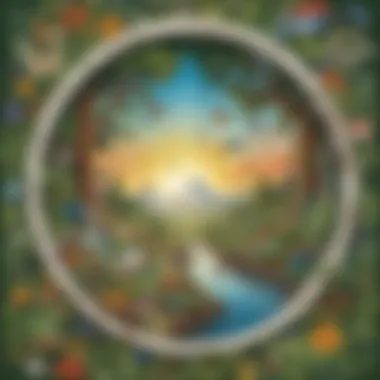Exploring the Intersection of Earth Day and Art: Inspiring Environmental Awareness through Creative Expression


Science Fun Facts
Earth Day is celebrated annually on April 22nd, originating in the United States in 1970 as a day to demonstrate support for environmental protection. Did you know that Earth Day is now recognized worldwide in over 192 countries? It serves as a reminder of the importance of respecting and caring for our planet's precious resources. From recycling initiatives to tree-planting campaigns, Earth Day encourages individuals to take proactive steps towards environmental conservation.
Discover the Wonders of Art and Nature
Art has the power to amplify environmental messages and evoke emotions that spur action. By exploring the intricate relationship between art and nature, individuals can gain a deeper understanding of environmental issues and the significance of sustainable living. Through creative expression, artists can inspire others to appreciate the beauty of the natural world and advocate for positive change. From vibrant eco-activist street murals to thought-provoking nature photography exhibitions, art serves as a powerful medium for raising awareness about environmental sustainability.
Artistic Endeavors for Environmental Conservation
Creative projects such as upcycling workshops, sculpture installations using recycled materials, and community murals depicting environmental themes play a vital role in fostering environmental consciousness. These hands-on initiatives not only encourage artistic expression but also promote eco-friendly practices and highlight the importance of repurposing materials. By engaging in art projects that center around environmental conservation, individuals can actively contribute to creating a more sustainable and visually captivating world.
Nature-Inspired Masterpieces and Environmental Advocacy
Nature serves as an abundant source of inspiration for artists, offering a wellspring of beauty and ecological diversity to draw upon. Through nature-inspired artworks, artists can convey messages of environmental stewardship and make strong statements about the need to protect our planet's ecosystems. From breathtaking landscape paintings to intricate botanical illustrations, these masterpieces remind audiences of the inherent value of preserving nature's unique marvels and galvanize support for environmental advocacy.
Cultivating Creativity for a Greener Tomorrow
Exploring Earth Day through art not only fuels creativity but also cultivates a sense of responsibility towards the environment. By engaging in artistic endeavors that promote sustainable practices and environmental awareness, individuals of all ages can play an active role in protecting the planet for future generations. Through a collective commitment to creativity and environmental stewardship, we can pave the way for a greener and more verdant tomorrow.
Introduction
In the realms of art and environmental awareness, the celebration of Earth Day marks a crucial juncture where creativity harmonizes with sustainability. This article embarks on a journey that explores the profound connection between Earth Day and art, showcasing how artistic expression serves as a catalyst for inspiring individuals to cherish and protect our planet. By delving into various artistic mediums and expressions, individuals can introspect on the significance of sustainability, conservation efforts, and the unparalleled beauty of our Earth. Through the lens of creativity, this narrative aims to illuminate the powerful correlation between artistry and environmental stewardship.
Understanding Earth Day
History and Significance
Unpacking the origins and importance of Earth Day unveils a pivotal moment in environmental activism. The historical backstory of Earth Day dates back to the 1970s when the modern environmental movement gained momentum globally. The significance of Earth Day lies in its ability to galvanize individuals and communities worldwide to advocate for environmental protection and sustainable practices. This pivotal event serves as a reminder of the collective responsibility humans bear towards safeguarding our planet for future generations. The inclusion of the history and significance of Earth Day in this article provides a historical context that underscores the enduring relevance of environmental advocacy in contemporary society.
Global Impact


Examining the global impact of Earth Day sheds light on its far-reaching influence on a planetary scale. Earth Day acts as a catalyst for mobilizing diverse stakeholders, including governments, organizations, and individuals, towards fostering environmental sustainability practices. The key characteristic of Earth Day's global impact lies in its ability to transcend geographical boundaries and inspire collective action in addressing pressing environmental challenges. This section delves into the universal resonance of Earth Day, emphasizing its role in promoting environmental consciousness and driving positive change worldwide.
The Role of Art in Advocacy
Art as a Vehicle for Change
Exploring the transformative power of art as a vehicle for change illuminates its pivotal role in advocating for environmental causes. Art possesses the intrinsic ability to evoke emotions, provoke critical thinking, and stimulate dialogue on pressing environmental issues. Through creative expression, artists leverage their craft to create impactful visual narratives that resonate with audiences, urging them to rethink their relationship with the natural world. The unique feature of art as a vehicle for change lies in its ability to transcend linguistic barriers, effectively communicating profound messages that spur individuals to embrace sustainable lifestyles.
Environmental Themes in Art
Unveiling the prevalent environmental themes in art underscores how artists harness their creativity to engage with ecological issues. Environmental themes in art serve as a visual medium through which artists convey their concerns about climate change, biodiversity loss, and other pressing environmental issues. The key characteristic of environmental themes in art is their ability to serve as a conduit for raising awareness and prompting constructive discussions on sustainability. By integrating these themes into their artistic expressions, creators play a pivotal role in prompting viewers to reflect on their impact on the environment and contemplate positive actions for conservation.
Exploring Eco-Friendly Art Projects
Exploring Eco-Friendly Art Projects plays a pivotal role in amplifying the essence of sustainability and environmental consciousness within the broader context of this article. By delving into the realm of eco-friendly art projects, individuals are not only showcasing their creativity but also making a profound statement about the importance of using sustainable practices in artistic endeavors. This section serves as a foundational pillar in linking artistic expression with environmental awareness, highlighting the significance of utilizing recycled materials and biodegradable art supplies in fostering a greener and more conscious artistic community.
Recycled Material Creations
In exploring Recycled Material Creations, one delves into the heart of sustainable artistry by repurposing materials that would otherwise contribute to environmental waste. The section is divided into two subheadings, each focusing on distinct yet interrelated aspects of eco-friendly creativity.
DIY projects for sustainability
DIY projects for sustainability stand as a testament to the ingenuity and resourcefulness of artists aiming to minimize their ecological footprint. Through these projects, individuals not only craft unique pieces but also actively participate in the conservation of resources. The charm of DIY projects lies in their ability to transform ordinary items into extraordinary works of art, instilling a sense of pride and environmental responsibility in creators. While these projects require dedication and effort, the satisfaction of knowing one has contributed positively to the environment adds an unparalleled depth to the artistic process.
Upcycling art ideas
Upcycling art ideas capture the essence of creativity with a purpose, emphasizing the transformative power of reimagining discarded materials. This approach not only reduces waste but also fosters a renewed appreciation for the inherent beauty found in everyday objects. Upcycling encourages artists to think outside the traditional norms of art creation, pushing boundaries and sparking innovative solutions to environmental challenges. While upcycling may pose certain challenges regarding material availability and suitability, its capacity to inspire sustainable practices and provoke thought on consumerism's impact makes it a vital component in promoting eco-friendly art projects.
Biodegradable Art Supplies
Within the realm of Biodegradable Art Supplies, artists are tasked with exploring innovative ways to express their creativity while minimizing their carbon footprint. This subsection sheds light on alternative materials and approaches that align with the overarching theme of environmental stewardship.
Natural alternatives for creative expression


Natural alternatives for creative expression offer artists a spectrum of environmentally conscious options to materialize their artistic visions. From plant-based pigments to organic canvases, these alternatives not only reduce reliance on synthetic materials but also infuse artworks with a sense of nature's authenticity. The unique textures and hues found in natural supplies contribute to the depth and richness of artistic creations, inviting viewers to connect with the environment on a more profound level.
Reducing carbon footprint
Reducing the carbon footprint through art supplies necessitates mindful consideration of the materials used in artistic endeavors. By opting for sustainable options such as biodegradable paints, recycled brushes, and eco-friendly canvases, artists actively participate in mitigating the environmental impact of their craft. While transitioning to biodegradable art supplies may require adjustments in procurement and practice, the long-term benefits of reducing carbon emissions and supporting sustainable industries far outweigh the initial challenges. The choice to prioritize eco-conscious materials not only elevates the quality of the artworks but also contributes to a broader narrative of environmental responsibility and creative sustainability.
Inspiring Nature-Inspired Masterpieces
In the realm of art and environmental awareness, the segment titled 'Inspiring Nature-Inspired Masterpieces' holds significant prominence. This section delves deep into the intricate connection between nature and artistic creativity, shedding light on how artists draw inspiration from the natural world to convey powerful messages. By exploring diverse artistic expressions, individuals can not only showcase the beauty of the environment but also raise awareness about the importance of preserving it. Nature-inspired masterpieces serve as a visual medium through which environmental narratives are portrayed, instilling a sense of responsibility and appreciation for the planet.
Floral and Fauna Artistry
Capturing the Essence of Nature
The subtopic 'Capturing the essence of nature' focuses on portraying the intrinsic beauty and essence of natural elements through art. This encompasses a detailed exploration of flora and fauna, aiming to replicate the delicate intricacies and vibrant hues found in the environment. Artists who excel in capturing the essence of nature often pay homage to biodiversity, highlighting the importance of every living creature and plant species. This approach not only celebrates the diversity of nature but also underscores the need for conservation and sustainability in the artistic realm. Despite its challenges, capturing the essence of nature offers artists a unique platform to showcase their skills while advocating for environmental preservation.
Symbolism in Botanical Art
The subheading 'Symbolism in botanical art' delves into the symbolic language embedded in artistic representations of plants and flowers. Artists use botanical motifs to convey deeper meanings, tapping into cultural significance and personal interpretations. Symbolism in botanical art adds layers of complexity to the visuals, inviting viewers to contemplate the intertwined relationship between humans and nature. By infusing botanical elements with symbolic value, artists lend a narrative quality to their work, sparking conversations about conservation, growth, and interconnectedness. This thematic approach enriches the artistic landscape, offering a tapestry of meanings that resonate with audiences and evoke appreciation for the natural world.
Landscape Interpretations
Scenic Portrayals of Natural Beauty
Within the domain of landscape interpretations, the focus lies on capturing the breathtaking beauty of natural settings through art. Artists adept at scenic portrayals aim to transport viewers to serene landscapes, inviting them to immerse themselves in the tranquility of untouched terrains. By showcasing nature's grandeur and majesty, artists evoke a sense of awe and admiration for the environment, prompting reflection on the need to safeguard such pristine vistas. The depiction of natural beauty through art serves as a poignant reminder of the fragility of ecosystems, urging viewers to cherish and protect our planet's natural wonders.
Impressions of Environmental Change
The concept of 'Impressions of environmental change' centers on depicting the evolving relationship between humanity and its surroundings. Through artistic lens, environmental shifts, such as deforestation, pollution, and climate change, are visualized to convey the impact of human activities on the planet. Artists who convey impressions of environmental change seek to raise awareness about pressing environmental issues, urging viewers to take action and advocate for sustainable practices. By showcasing the juxtaposition of untouched landscapes and human-altered terrains, artists prompt contemplation on the consequences of unsustainable practices, urging society to embrace conservation and eco-conscious behaviors.
Fostering Environmental Awareness through Art Education


Fostering Environmental Awareness through Art Education plays a pivotal role in this article as it highlights the crucial connection between art and environmental consciousness. By integrating art education with environmental themes, individuals, especially children, can deepen their understanding of sustainability and conservation. This section focuses on the significant benefits of including art in education, such as fostering creativity, critical thinking, and a sense of environmental responsibility. Through art education, children can develop a holistic approach towards addressing environmental issues, encouraging them to become custodians of the planet.
School Programs and Community Initiatives
Promoting eco-conscious creativity
Promoting eco-conscious creativity is a fundamental aspect of engaging students in environmentally-focused art activities. This approach emphasizes the use of sustainable materials, recycling, and upcycling in artistic creations. By promoting eco-conscious practices, students not only explore their creative potential but also learn to minimize waste and reduce their ecological footprint. The key characteristic of promoting eco-conscious creativity lies in fostering a mindset of environmental stewardship through artistic expression, making it an essential element in cultivating sustainable practices among young learners.
Collaborative art projects
Collaborative art projects further enhance the overall environmental awareness goal by encouraging teamwork, empathy, and shared responsibility. By working together on art initiatives, students not only develop their artistic skills but also learn the value of cooperation and collective effort in addressing environmental challenges. The unique feature of collaborative art projects is the sense of community they foster, inspiring participants to create art that reflects their shared commitment to sustainability. While collaborative projects offer a platform for meaningful engagement, they may also pose challenges in coordinating group dynamics and managing diverse creative perspectives.
Art Curriculum Integration
Interdisciplinary approaches to sustainability education
Integrating interdisciplinary approaches to sustainability education into the art curriculum enriches students' learning experiences by connecting various subject areas with environmental themes. This approach highlights the interconnectedness of art, science, and social studies, providing students with a holistic understanding of sustainability issues. The key characteristic of interdisciplinary sustainability education lies in promoting cross-disciplinary thinking and problem-solving skills, enabling students to analyze environmental challenges from different perspectives. By integrating sustainability across disciplines, students can develop a comprehensive view of environmental issues and explore innovative solutions through creative expression.
Artistic appreciation of the natural world
Artistic appreciation of the natural world plays a crucial role in fostering a deep connection between students and the environment. By encouraging students to explore and capture the beauty of nature through art, educators inspire a sense of wonder and reverence for the natural world. The key characteristic of artistic appreciation lies in cultivating observational skills, creativity, and emotional engagement with nature, instilling in students a profound respect for the environment. The unique feature of this approach is its ability to transcend cultural and linguistic barriers, allowing students to express their feelings about nature through diverse artistic mediums. While promoting artistic appreciation offers a holistic approach to environmental education, it may also present challenges in balancing technical skills development with creative expression.
Conclusion
In the culmination of this detailed exploration of Earth Day through art, it becomes evident that artistic expression serves as a potent tool for cultivating environmental awareness and inspiring action. The linkage between creativity and sustainability is fundamental, prompting individuals to reflect on the significance of conservation and the intrinsic beauty of our planet. Through eco-friendly projects and nature-inspired masterpieces, the narrative unfolds a compelling connection between art and environmental stewardship, urging us to embrace our roles as responsible custodians of the Earth.
Empowering Change through Artistic Expression
Encouraging Activism Through Creativity
Embarking on the journey of encouraging activism through creativity signifies a powerful force in fostering meaningful change and raising awareness on environmental issues. This aspect of artistic expression harnesses the persuasive influence of creative endeavors to spark dialogue, provoke reflections, and ignite action within communities and individuals alike. By amplifying voices through innovative and thought-provoking means, encouraging activism through creativity becomes a catalyst for catalyzing societal transformations and influencing collective mindsets toward sustainable practices.
Considering its pivotal role in the broader context of this article, encouraging activism through creativity stands out as a versatile and impactful strategy for driving positive change. Its ability to bridge artistry with advocacy not only enhances engagement but also amplifies the reach and resonance of environmental messages. The distinct characteristic of enabling individuals to connect emotionally with pressing eco-centric concerns underscores its efficacy in mobilizing diverse audiences toward shared environmental goals, making it a strategic and compelling choice in advancing the central themes of this narrative. Moreover, the unique feature of fostering a sense of empowerment and agency among participants accentuates its advantageous position in shaping attitudes and behaviors, fueling a collective momentum towards sustainable activism within the realm of artistic expression.
Sustaining Environmental Advocacy
Sustaining environmental advocacy emerges as a critical element in upholding long-term commitments to environmental causes and nurturing a culture of proactive conservation. This facet of artistic expression plays a pivotal role in maintaining consistent efforts to promote environmental stewardship, ensuring that sustainability remains at the forefront of artistic endeavors and societal consciousness. By embodying environmental values and principles through creative outputs, sustaining environmental advocacy perpetuates the momentum of eco-conscious initiatives, fostering a lasting impact on both local and global scales.
Within the context of this article, the key characteristic of sustaining environmental advocacy lies in its capacity to instill a sense of responsibility and custodianship towards the environment. By cultivating a sustained dialogue and engagement with environmental issues, this aspect of artistry deeply integrates ecological considerations into societal discourses and individual practices, thus reinforcing the ethos of environmental consciousness. Its significance as a recurring theme echoes the necessity for continuous reflection and action in the face of environmental challenges, positioning it as an integral force in propelling the overarching message of this narrative. Additionally, the unique feature of promoting ongoing dialogues and collaborations amidst diverse stakeholders underscores its advantages in fostering collective accountability and advocacy within the domain of art, strengthening the resolve towards sustainable environmental practices and enduring conservation efforts.







